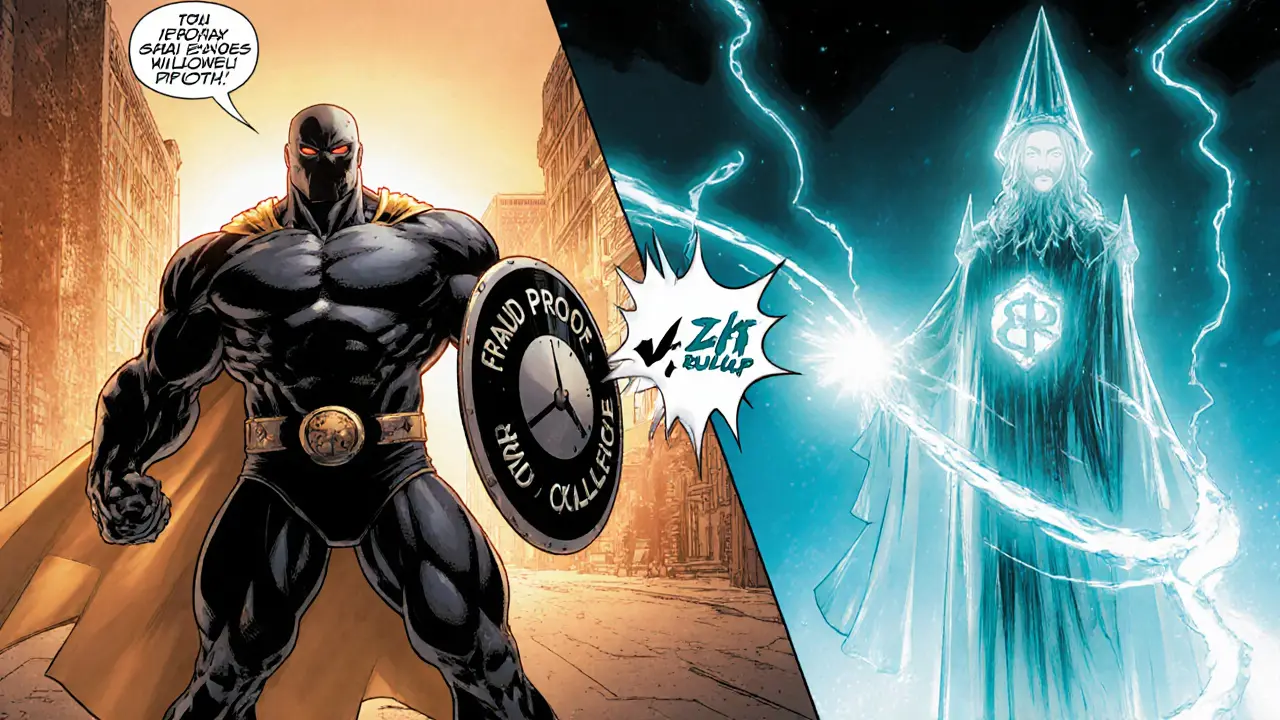Ethereum Rollup Performance Calculator
Rollup Performance Summary
Rollup Type:
Estimated TPS:
Average Gas Fee:
Daily Transactions:
Monthly Cost on Mainnet:
Monthly Cost on Rollup:
Key Features Comparison
| Feature | Optimistic Rollup | ZK Rollup |
|---|---|---|
| Verification Method | Fraud proofs (challenge period) | Zero-knowledge proofs |
| Finality Speed | 1-7 days for withdrawals | Instant finality |
| Typical TPS | 1,000-2,000 TPS | 2,000-4,000 TPS |
| Developer Complexity | Lower (EVM compatible) | Higher (requires proof generation) |
Ethereum can only handle about 15‑20 transactions per second (TPS). When demand spikes, fees skyrocket and the network feels sluggish. Ethereum rollups are the game‑changer that lets the blockchain process thousands of transactions without sacrificing security or decentralization.
Key Takeaways
- Rollups bundle dozens of L2 transactions into a single L1 batch, keeping security on Ethereum.
- Two main families exist: optimistic rollups (e.g., Arbitrum, Optimism) and zero‑knowledge (ZK) rollups (e.g., zkSync, StarkNet).
- Both types lift Ethereum from ~20TPS to 1,000‑4,000TPS; combined with future sharding they could reach 100,000TPS.
- Optimistic rollups trade instant finality for simpler implementation; ZK rollups give immediate finality but need heavy computation.
- Developers can reuse existing Solidity contracts on most rollups thanks to EVM compatibility.
What Exactly Is a Rollup?
In the Ethereum ecosystem, a Rollup is a Layer2 scaling construct that aggregates many transactions off‑chain, then posts a compressed proof or state update back to the main chain. The rollup’s smart contracts on L1 act as the gatekeeper: they verify the batch and settle the final state. Because the security check happens on the base layer, users inherit Ethereum’s robust consensus while enjoying dramatically lower gas costs.
How Rollups Work Under the Hood
Every rollup runs its own execution environment-think of it as a side‑chain that never diverges from Ethereum’s state. When users submit a transaction, the rollup node processes it, updates the rollup’s state tree, and stores the new state root. Periodically, the rollup publishes either a cryptographic proof (ZK) or just the new state root (optimistic) to the mainnet. The L1 contract validates the proof or, in the optimistic case, opens a challenge window during which anyone can dispute fraudulent batches.
Optimistic vs. ZK Rollups - A Side‑by‑Side Look
| Feature | Optimistic Rollup | ZK Rollup |
|---|---|---|
| Verification Method | Fraud proofs (challenge period) | Zero‑knowledge proofs (validity proofs) |
| Finality Speed | Withdrawals wait 1‑7days (challenge period) | Instant finality once proof is posted |
| Typical TPS | 1,000‑2,000TPS | 2,000‑4,000TPS |
| Developer Complexity | Lower - uses familiar EVM semantics | Higher - requires proof‑generation infrastructure |
| Major Projects | Arbitrum, Optimism | zkSync, StarkNet |
Why Rollups Beat Other Scaling Options
State channels excel for payments between a fixed set of parties but crumble when you need a public marketplace. Sidechains run their own consensus, so they sacrifice Ethereum’s security guarantees. Rollups, by contrast, inherit security directly from the base layer, making them a general‑purpose, EVM‑compatible scaling path. This means a DeFi contract written for mainnet can be redeployed on a rollup with little or no code change.

Synergy with Ethereum’s Roadmap
The Merge (September2022) switched Ethereum from proof‑of‑work to proof‑of‑stake, cutting energy use and laying the groundwork for data‑availability improvements. The next big milestone is sharding a set of parallel data lanes that expands the amount of transaction data the network can store per block. When shards become available, rollups can spread their batches across many shards, pushing theoretical throughput toward the 100,000TPS target touted by the community.
Real‑World Rollup Deployments
Today, the most active rollups include:
- Arbitrum - an optimistic rollup known for low latency and a solid developer portal.
- Optimism - another optimistic solution focusing on simplicity and compatibility.
- zkSync - a ZK rollup built by Matter Labs, praised for sub‑dollar fees.
- StarkNet - a ZK rollup using STARK proofs, offering high scalability for complex dApps.
All four let developers write Solidity code, connect to familiar wallets, and enjoy dramatically cheaper gas. The primary difference lies in withdrawal speed and the hardware needed to generate proofs.
Cost Savings in Practice
On mainnet, a simple ERC‑20 transfer can cost $20‑$30 during peak demand. On Arbitrum or Optimism, the same transfer drops to <$0.10. ZK rollups push that even lower-often under $0.01-because most computation stays off‑chain and only a succinct proof hits L1.
Implementation Tips for Developers
- Pick a rollup that matches your latency needs. If users expect instant withdrawals, a ZK rollup makes sense.
- Use the rollup’s official SDKs (e.g.,
@arbitrum/sdk,zksync-web3) to handle bridge interactions and transaction signing. - Test on the rollup’s testnet before moving to mainnet; most projects provide a faucet for test ETH.
- Monitor the challenge window (for optimistic rollups) and be ready to submit fraud proofs if you spot suspicious activity.
- Keep an eye on data‑availability costs; as ETH’s base fee drops, rollup batch fees will follow suit.
Future Outlook: Toward 100k TPS
Researchers predict that with full sharding, rollups could literally multiply Ethereum’s capacity by 5‑10×. Ongoing work on "any‑trust" data‑availability layers (e.g., Celestia) may let rollups publish calldata without relying on Ethereum’s block size, freeing even more space for transaction batches. The combined effect: truly global, low‑cost, decentralized applications-from DeFi to gaming-running at Web‑scale speeds.
Frequently Asked Questions
What is the main difference between optimistic and ZK rollups?
Optimistic rollups assume transactions are valid and rely on a challenge period where anyone can submit a fraud proof. ZK rollups generate a cryptographic proof that verifies every transaction instantly, eliminating the need for a challenge window.
Do I need to rewrite my Solidity contracts to deploy on a rollup?
Most rollups are EVM‑compatible, so you can redeploy the same bytecode. Minor tweaks may be required for gas‑optimizations or to interact with rollup‑specific bridge contracts.
How much cheaper are rollup transactions compared to mainnet?
During typical network conditions, optimistic rollups cut fees by 95‑99%, while ZK rollups often go below a cent for simple token transfers.
Can I move assets back to Ethereum mainnet from a rollup?
Yes, via a bridge contract. Optimistic rollups require waiting through the challenge period (usually 1‑7days); ZK rollups settle instantly.
Will rollups become obsolete after Ethereum fully shards?
No. Sharding expands data availability, but rollups still provide the execution layer that aggregates transactions. The two are complementary, not competing.


Tilly Fluf
January 7, 2025 AT 18:43Dear community, I commend the thorough exposition on rollup mechanisms; your effort elucidates the nuanced trade‑offs between optimistic and ZK solutions, and I trust that this knowledge will empower newcomers to make informed choices.
Shanthan Jogavajjala
January 14, 2025 AT 10:43While your appreciation is noted, it's imperative to dissect the data‑availability layers underpinning rollup security, particularly the ramifications of calldata compression on L1 throughput and the ensuing attestations required for fraud‑proof verification.
Millsaps Delaine
January 21, 2025 AT 02:43One must first acknowledge that the discourse surrounding Ethereum rollups has attained a level of sophistication that rivals many other blockchain scaling debates, yet the superficial treatment of these topics in popular media still betrays a lack of depth that is, frankly, disheartening. The dichotomy between optimistic and zero‑knowledge rollups is not merely a binary of speed versus security; rather, it encapsulates a spectrum of design philosophies that reflect divergent priorities in decentralization, latency, and computational overhead. Optimistic rollups, by delegating dispute resolution to an ex post facto mechanism, accept a latency penalty in exchange for a leaner verification pipeline, which, in turn, reduces the burden on prover infrastructure. Conversely, ZK rollups demand substantial cryptographic computation up front, resulting in near‑instant finality but imposing a higher barrier to entry for developers unfamiliar with STARKs or PLONKs. Moreover, the economic incentives embedded within each paradigm dictate distinct attacker models: optimistic rollups rely on the presence of vigilant challengers, whereas ZK rollups trust the mathematical soundness of the proof system. It is also worth noting that the choice of rollup can influence user experience in subtle ways, such as the UX of token bridges and the latency of cross‑rollup messaging. From a developer standpoint, the EVM compatibility of optimistic solutions simplifies migration paths, yet the evolving tooling around ZK rollups is rapidly narrowing this gap. The long‑term viability of either approach may ultimately hinge on the successful integration of data availability layers and the forthcoming sharding upgrades, which promise to multiply the capacity of the underlying base layer. In practice, the observed fee reductions on Arbitrum and zkSync have already demonstrated tangible benefits for end‑users, but the community must remain vigilant about the trade‑offs in prover costs and potential centralization pressures. Finally, a robust scaling strategy for Ethereum will likely incorporate a heterogeneous ecosystem of rollups, each optimized for specific use‑cases, rather than a monolithic solution that attempts to serve all workloads uniformly.
Kevin Fellows
January 27, 2025 AT 18:43Great points! Happy to see the community digging into the technical details.
Gaurav Gautam
February 3, 2025 AT 10:43Hey folks, just wanted to add that the diversity of rollup solutions really helps the ecosystem stay resilient, especially when one layer faces congestion.
Samuel Wilson
February 10, 2025 AT 02:43Indeed, maintaining multiple rollup pathways enhances redundancy; users can switch to an alternative if gas spikes occur on a particular L2, thereby preserving overall network fluidity.
Fiona Chow
February 16, 2025 AT 18:43Wow, another brilliant summary-except I’m still waiting for someone to explain why we’re still stuck with L1 fees when the rollups claim to solve everything.
Rebecca Stowe
February 23, 2025 AT 10:43Stay positive, the tech keeps improving.
Aditya Raj Gontia
March 2, 2025 AT 02:43Honestly, this whole rollup hype feels like just another marketing buzzword until real user adoption numbers drop.
Kailey Shelton
March 8, 2025 AT 18:43Same here, the actual impact seems minimal compared to the hype.
mannu kumar rajpoot
March 15, 2025 AT 10:43The mainstream narrative ignores the underlying centralization risks inherent in data‑availability committees that many rollups secretly depend upon.
Anthony R
March 22, 2025 AT 02:43Interesting observation; however, it should be noted that such committees are governed by transparent on‑chain voting mechanisms, ensuring accountability.
Linda Welch
March 28, 2025 AT 18:43Wow, yet another post glorifying rollups while pretending they’ll magically fix everything-yeah, right. The truth is that most users still pay sky‑high fees, and the so‑called "instant finality" is just a marketing gimmick.
Cindy Hernandez
April 4, 2025 AT 10:43Actually, many rollups have demonstrated sub‑dollar transaction costs, especially zkSync on its latest testnet, which shows real progress beyond hype.
victor white
April 11, 2025 AT 02:43One cannot overlook the subtle orchestration behind the scenes, where elite engineers manipulate proof systems to veil the true computational burden.
mark gray
April 17, 2025 AT 18:43The community benefits when we keep discussions transparent and focus on practical improvements rather than conspiratorial narratives.
Alie Thompson
April 24, 2025 AT 10:43It is with a sense of moral urgency that I must call out the complacency that pervades discussions of Ethereum scaling; we cannot simply accept incremental optimizations as a panacea for the systemic inequities that have long plagued the network. The notion that rollups alone will democratize access ignores the structural power dynamics embedded in the protocol's governance and the economic incentives that favor well‑funded entities. Moreover, the very design of many rollups concentrates data availability responsibilities in a handful of operators, effectively re‑centralizing the very resource they claim to distribute. This selective transparency fosters an environment where the disenfranchised are left to navigate opaque fee structures and unpredictable withdrawal delays. To truly uphold the ethos of decentralization, we must demand open‑source tooling, equitable validator participation, and robust cross‑rollup interoperability. In short, scaling is not a purely technical challenge but a socio‑economic one that demands collective vigilance.
Danny Locher
May 1, 2025 AT 02:43Solid points. It’s key we keep an eye on both the tech and the broader impact.
Emily Pelton
May 7, 2025 AT 18:43Indeed-let’s encourage inclusive development, ensure documentation is accessible, and push for community‑driven governance; only then can we claim true progress.